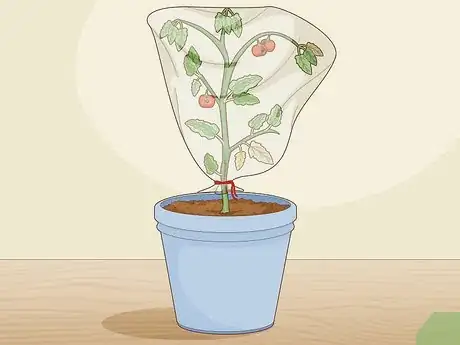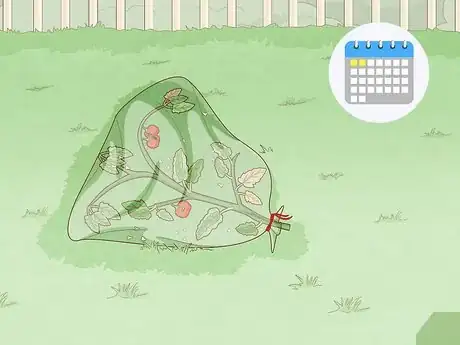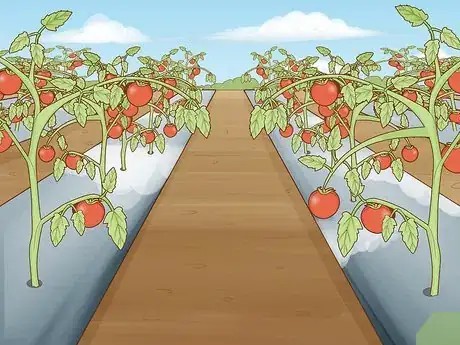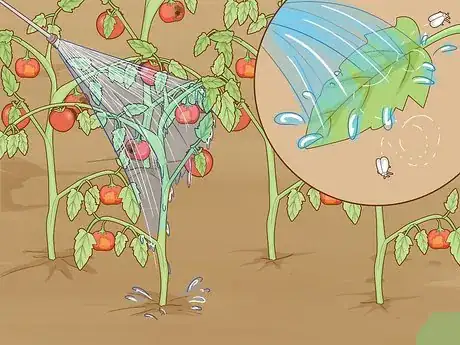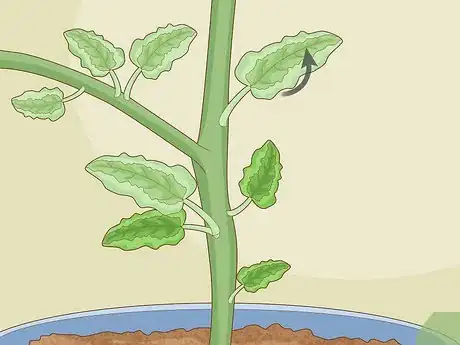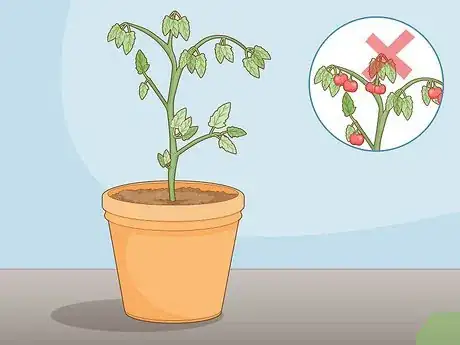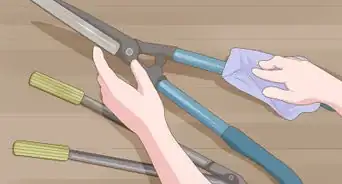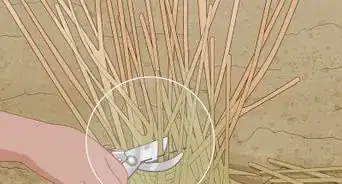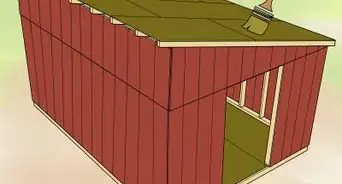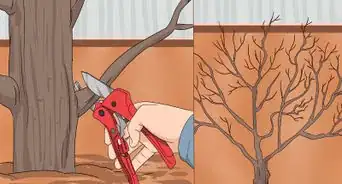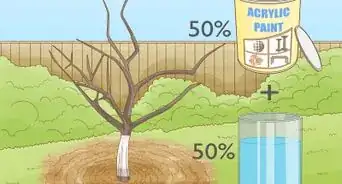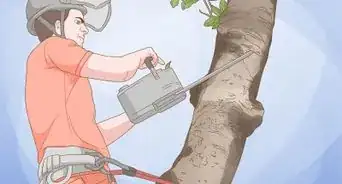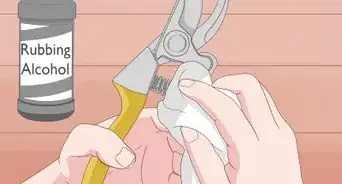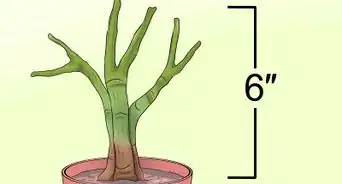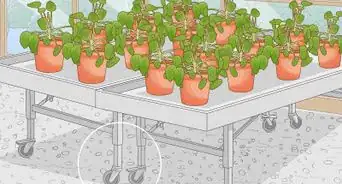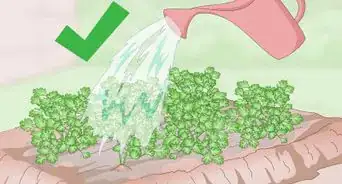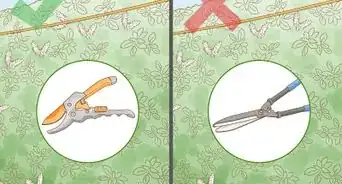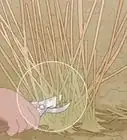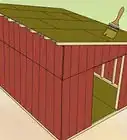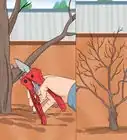This article was co-authored by wikiHow Staff. Our trained team of editors and researchers validate articles for accuracy and comprehensiveness. wikiHow's Content Management Team carefully monitors the work from our editorial staff to ensure that each article is backed by trusted research and meets our high quality standards.
This article has been viewed 11,234 times.
Learn more...
Tomato Leaf Curl Virus (TLCV) is a disease that causes tomato plants to wither, stop growing fruit, and eventually die. It is caused by whitefly infestations on the tomato plants. Unfortunately, there is no cure for TLCV, so the only answer is removing infected plants to prevent the disease from spreading. Inspect your plants to find the symptoms of TLCV, and remove any that show symptoms. Prevent the disease by avoiding plants from disease-prone areas, keeping your garden clean, and using reflective mulch and row covers to keep whiteflies off the plants.
Steps
Removing Infected Plants
-
1Cover the entire plant with a plastic bag and tie it at the stem. Before removing the plant, make sure the infected leaves and white flies are contained so they can’t infect the rest of the garden. Take a long plastic bag and put it over the top of the plant. Stretch it down to the plant stem, just above the soil level. Then tie the bag tightly around the plant stem.[1]
- Make sure the seal on the bag is tight and it has no holes so the whiteflies won’t escape.
- Don’t pull the plant out without covering it first. The whiteflies will flee when you start cutting the plant and will infect other ones in the garden.
-
2Cut the plant stem below the bag. Use a sharp pair of shears and cut the stem clean through. Double check to make sure the bag remains tightly-sealed around the stem and no flies can escape.[2]Advertisement
-
3Let the bag sit in the garden for 1-2 days so the flies die. Don’t throw the bag out right away. Let it sit in the sun for up to 2 days so the flies and infected leaves die off. Then there is no risk of them escaping and infecting the rest of your garden.[3]
- Moving the bag to the trash right away could break the seal and let the flies escape.
-
4Throw the bag in a trash bin. After 2 days, then throw the bag away. Throw it in your regular garbage to keep it separate from your plants, or anything else that will end up back in your garden.[4]
- Do not use these plants for compost. They can infect the rest of your garden with the virus.
Preventing the Disease
-
1Remove any debris leftover in your garden from the previous season. Dead plants, leaves, roots, and weeds can attract pests like whiteflies and encourage mold growth. Always clean your garden thoroughly after the planting season ends. Rake out dead plants and pull old weeds up. Keep your garden clean throughout the winter.[5]
- If you’ve had outbreaks of TLCV in the previous season, then don’t compost any of this debris. Throw it out instead to prevent spreading it to your new plants.
-
2Avoid importing plants from virus-prone areas. In the North America, some areas are much more prone to TLCV outbreaks. Florida, Georgia, Texas, and Mexico are particular hotspots. If you’re selecting plants, avoid ones imported from these areas. They may already be infected with the disease if they were grown there.[6]
- If you’re buying seedlings from your local nursery, ask where they came from.
- Note that this doesn’t refer to seeds produced in these areas. It only refers to seedlings that have sprouted and grown for any amount of time in these areas, and had a chance to get infected by whiteflies.
- There have been experiments in breeding tomato strains resistant to TLCV, but they haven’t been very successful. The best option is avoiding plants produced in areas where the disease is common.
-
3Plant away from areas that had TLCV outbreaks the previous season. If you have a large property with multiple fields, then plant far away from a field that had a whitefly or TLCV infestation the previous season. The whiteflies may return to the same spot and re-infect your new plants.[7]
- If you plant melons or cotton, these are also whitefly hosts. Locate your tomatoes at least 1⁄2 mile (0.80 km) from these crops to prevent cross-infestation.
- If you have a small property, then this probably isn't possible. In this case, clean the area very well before planting to remove any debris that might be housing whiteflies.
-
4Place row covers over your plants to prevent whitefly infections. Row covers are mesh coverings that keep pests like whiteflies off the plants. If whiteflies are a problem in your area, then cover all your plants to stop whiteflies from colonizing them and spreading TLCV.[8]
- Some row covers don’t let in enough sunlight to let the plants thrive. Check your brand to see if it instructs you to leave the covers off for a few hours each day so the plants get enough sunlight. 4-6 hours is a common requirement.
-
5Spread reflective mulch around your plants to repel whiteflies. Plastic reflective mulches are sometimes effective in keeping whiteflies away. Start by removing all the weeds in your garden. Then spread a 1 in (2.5 cm) layer around your garden to prevent whiteflies from colonizing your plants.[9]
- Reflective mulch is available at hardware or garden stores and nurseries.
-
6Apply neem oil to the plants if you see whiteflies. Neem oil is a natural pesticide that helps repel whiteflies and other pests. Get a bottle from your local nursery or garden store as soon as you see whiteflies on your plants. Spray the entire tomato plant every 7-14 days. Remember to get the underside of leaves as well.[10]
- Neem oil breaks down naturally and is not toxic to humans or animals. It can, however, cause skin or eye irritations, so wear gloves and goggles when applying it.
- Don't use strong, chemical insecticides. These can kill other insects that are natural enemies of whiteflies, and consequently cause the whitefly population to grow.
-
7Spray whiteflies off with a strong stream from a hose. If you don't have access to neem oil or other pesticides, a strong stream from a hose and push whiteflies off the plants. Set your hose to a heavy stream and spray it directly onto the whiteflies. Then spray the rest of the plants to get rid of any colonies you may have missed.[11]
- Remember that strong hose streams may also damage your plants. Only use this method if you don't have other choices.
Recognizing the Symptoms
-
1Inspect your plants for whiteflies. Since whiteflies spread TLCV, the earliest indication that your plant could be infected is a whitefly infestation. Whiteflies, as the name implies, have white wings with a slightly cream-colored body. They usually live in clusters on leaves. Check your plants twice per week to ensure you don’t have any infestations.[12]
- If you do find whiteflies, cut off the leaves that they’re on. This could prevent them from spreading further and save the plant.
-
2Check for yellowing and faded leaves. Most signs of TLCV appear on the tomato leaves. The earliest sign is a faded color on the leaves. Eventually, the leaves will turn yellow, starting from the tips. Although this can be a symptom of several different problems, it’s an early sign of TLCV.[13]
- If you see any plants at the nursery with faded or yellowing leaves, don’t buy them. They could already be infected.
- At this point, it’s too early to diagnose TLCV. Yellow leaves can have several causes, including fungal infections, infestations from insect pests, and nutrient deficiencies.[14]
-
3Look for dried-out leaves that curl upwards. After the leaves yellow slightly, they will start curling up. This is a telltale sign of TLCV. If there are no other symptoms indicating a different disease, then at this point you can conclude that the plant has TLCV.
- The upward curl is what distinguishes TLCV from other infections, which usually cause the leaves to wilt downward. The upward curl is a staple of TLCV.
- If your plant has grown any fruit, the small leaves above the fruit may also curl up.
-
4Notice reduced or no fruit growth on the plant. In addition to symptoms showing on the leaves, TLCV also prevents the plant from growing fruit or flowers. An infected plant will grow few or no fruits, and the fruits that do grow won’t reach maturity.[15]
- Fruit may grow for a short time and then fall off before reaching maturity. Flowers may also bloom shortly but then wilt and fall off.
References
- ↑ http://ipm.ifas.ufl.edu/Agricultural_IPM/tylcv_home_mgmt.shtml
- ↑ http://ipm.ifas.ufl.edu/Agricultural_IPM/tylcv_home_mgmt.shtml
- ↑ http://ipm.ifas.ufl.edu/Agricultural_IPM/tylcv_home_mgmt.shtml
- ↑ http://ipm.ifas.ufl.edu/Agricultural_IPM/tylcv_home_mgmt.shtml
- ↑ https://www2.ipm.ucanr.edu/agriculture/tomato/Whiteflies/#MANAGEMENT
- ↑ https://www2.ipm.ucanr.edu/agriculture/tomato/Tomato-Yellow-Leaf-Curl/
- ↑ https://www2.ipm.ucanr.edu/agriculture/tomato/Tomato-Yellow-Leaf-Curl/
- ↑ https://www2.ipm.ucanr.edu/agriculture/tomato/Tomato-Yellow-Leaf-Curl/
- ↑ http://ipm.ucanr.edu/PMG/PESTNOTES/pn7401.html
- ↑ http://ipm.ucanr.edu/PMG/PESTNOTES/pn7401.html
- ↑ http://ipm.ucanr.edu/PMG/PESTNOTES/pn7401.html
- ↑ http://ipm.ucanr.edu/PMG/PESTNOTES/pn7401.html
- ↑ http://ipm.ifas.ufl.edu/Agricultural_IPM/tylcv_home_mgmt.shtml
- ↑ https://extension.colostate.edu/topic-areas/yard-garden/recognizing-tomato-problems-2-949/
- ↑ https://www2.ipm.ucanr.edu/agriculture/tomato/Tomato-Yellow-Leaf-Curl/
